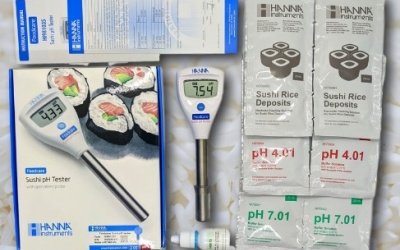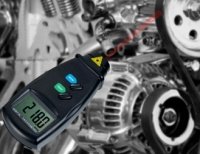Get Food Safe and Get Equipped With a Sushi pH Tester Kit

Sushi pH Tester Kits are an affordable, quick and easy way to verify that the pH of your sushi rice is safe and within regulatory defined limits.
In this article, the Instrument Choice team recommends five sushi pH measuring kits complete with everything you need to perform accurate sushi rice pH measurements.
We thought you might like to check out our experts’ recommendations.
Why Test the pH of Sushi Rice
Sushi is immensely popular in Australia. However, as sushi contains several perishable and high-risk ingredients and involves a significant degree of manual handling during preparation, it is regarded as a potentially hazardous food in many states and territories.
One such ingredient is sushi rice. The NSW Food Authority has identified pH <4.6 as the critical pH level for rice in its Food Safety Guidelines for Preparing and Displaying Sushi (NSW Food Authority, 2007). Therefore, when sushi rice is acidified using acetic acid (vinegar) to a pH of less than 4.6, it is no longer considered a potentially hazardous food as the pH will not support the growth of most pathogens.
What to Look For in a Sushi pH Tester
- Minimum two-point calibration– Calibrating the pH Tester to two points along the linear pH equation ensures your meter is accurate.
- Temperature compensation – Temperature affects pH. Temperature compensation takes the temperature of the sample into account when taking a pH reading. pH tester with this feature automatically adjust results for fluctuating temperature, removing the need for a manual correction.
- Accuracy – Accuracy is the closeness of a measurement to a specific value. Specifications will express the accuracy of a device as plus or minus a set amount.
Why a Sushi pH Tester Kit Is Essential
pH measurement of sushi rice is a straightforward risk mitigation task. However, measuring the pH of sushi rice is fruitless if your pH tester is not accurate!
A complete sushi pH kit comes with the essential calibration buffer solutions to ensure your pH tester takes reliable measurements. For the recommended two-point calibration, you will need buffers that sit on either side of the expected sample pH. For sushi rice measurements, these are; pH 4.01 and 7.01.
Other solutions that will help ensure precise readings are listed below. These solutions are included in some sushi pH tester kits or can be separately purchased when required.
- Storage Solution: Storage solutions keep the electrode bulb of a food pH Tester hydrated and ensure accurate results.
- Cleaning Solution: Over time, a layer of grime could build up on your pH electrode, potentially causing measurement errors. You will need a cleaning solution to adequately and safely clean your meter.
| Browse storage and cleaning solutions here |
Sushi pH Tester Kits
Foodcare Sushi pH Tester
|
|
Sushi Rice pH Tester Kit
|
|
|
Conclusion
A Sushi Rice pH Tester Kit is an affordable way to ensure you are meeting your state and territory food safety requirements.
If you need assistance or advice selecting the best Sushi pH Tester Kit for your application, speak with an Instrument Choice Scientist! Call 1300 737 871 or email [email protected].
Additional Articles:
Also interesting
The Fluke 62 Max and Fluke 62 Max Plus Thermometers have the precision you need to do your job accurately – without breaking the budget.
So that you can choose the most suitable Fluke Thermometer for your application, our scientists have put together a technical comparison between the Fluke 62 Max and Fluke 62 Max Plus.
Uncover the key differences between the Fluke 62 Max series of thermometers

A digital tachometer is a handheld device designed to measure the rotational speed of a disk or shaft. This type of instrument expresses results in revolutions per minute (RPM).
In this article, we define contact and non-contact tachometers while providing some product examples so that you can choose the correct tachometer for your needs!
Contact vs non-contact tachometers – get your guide here

